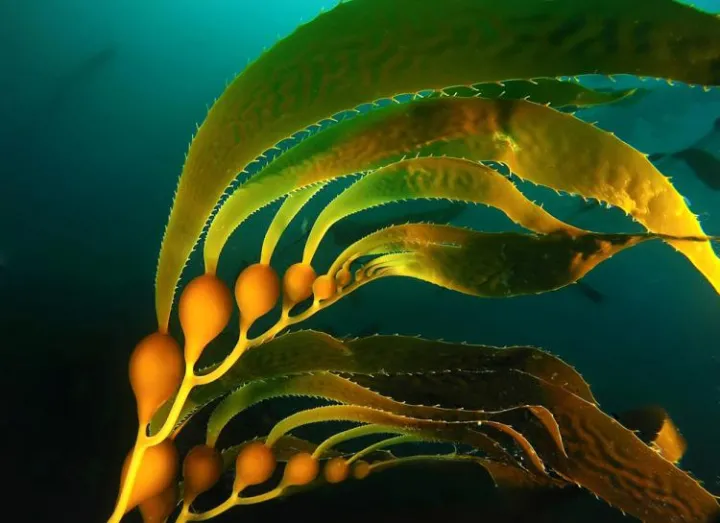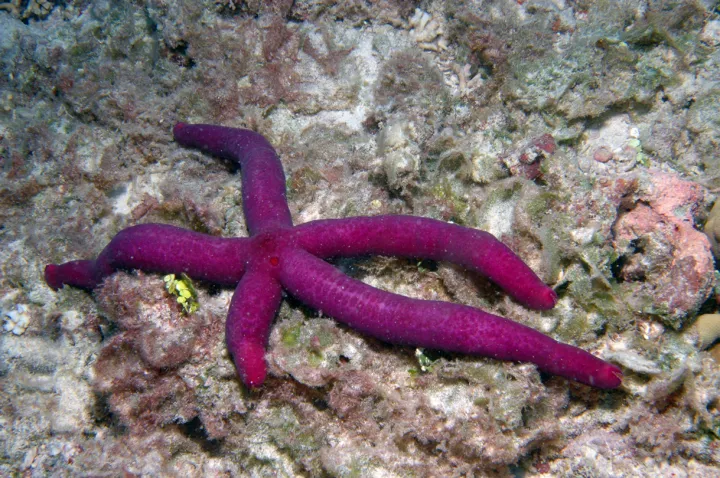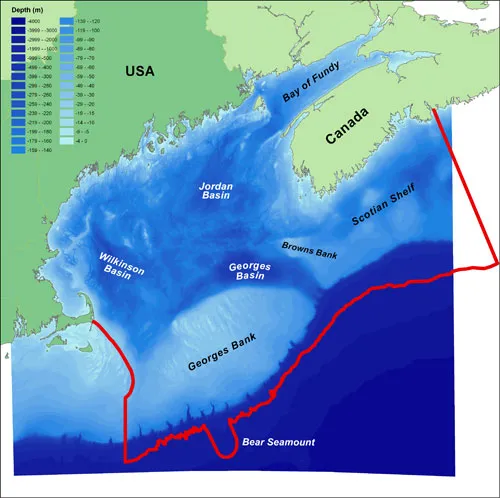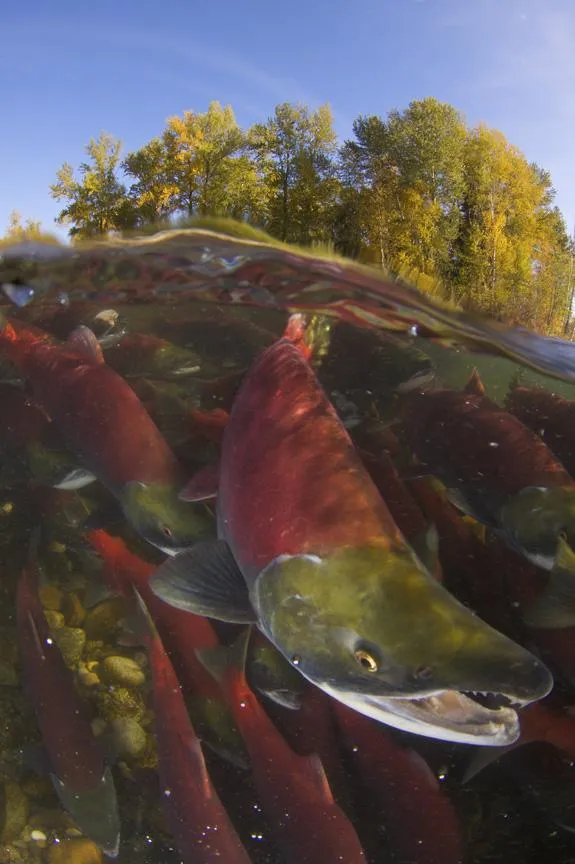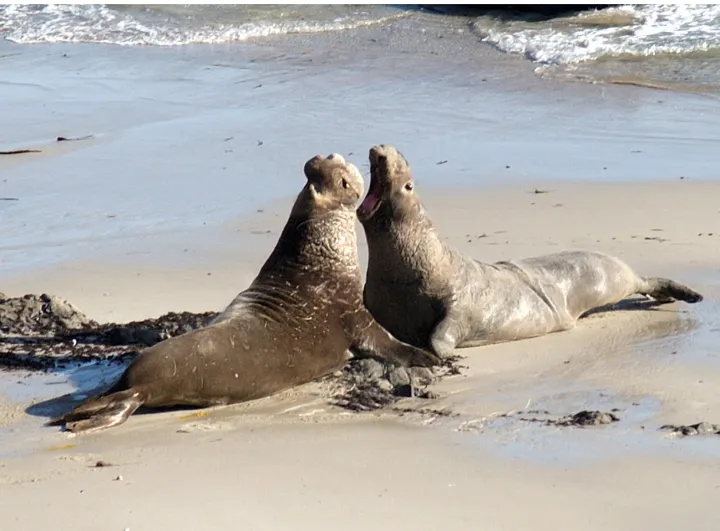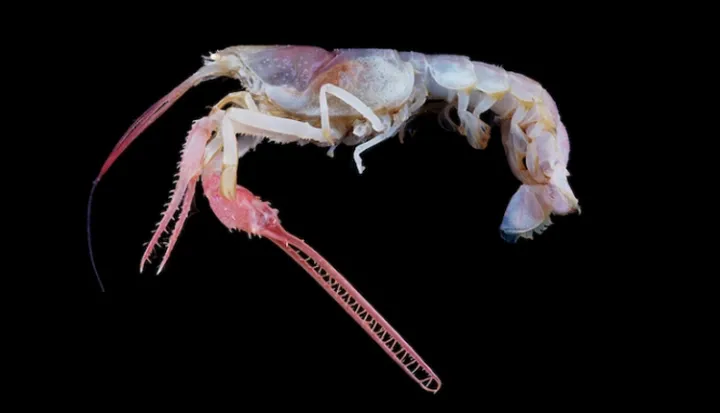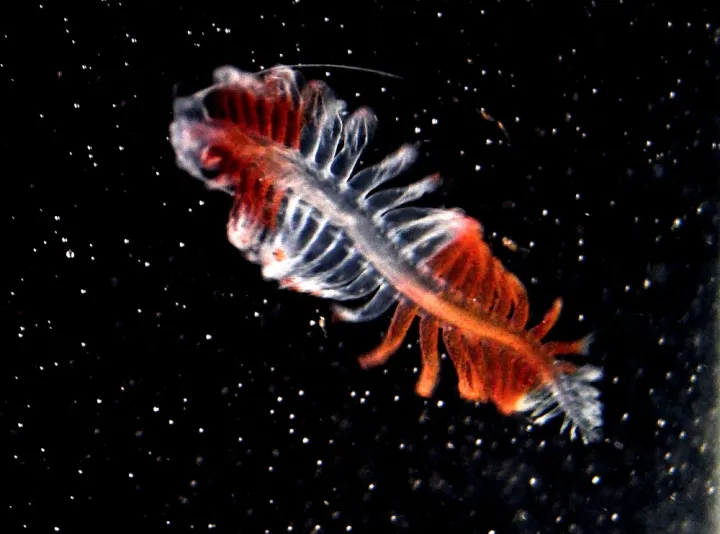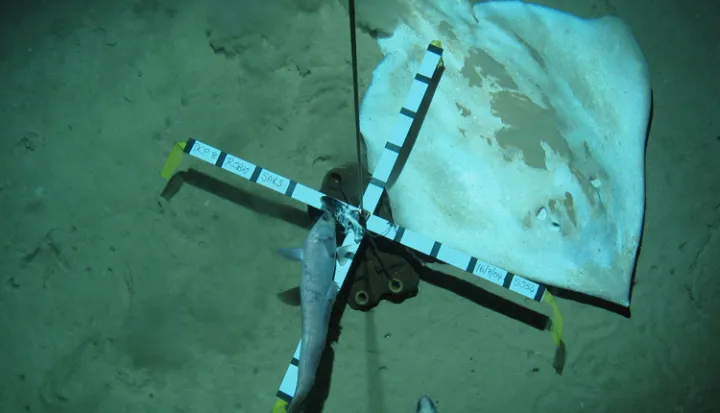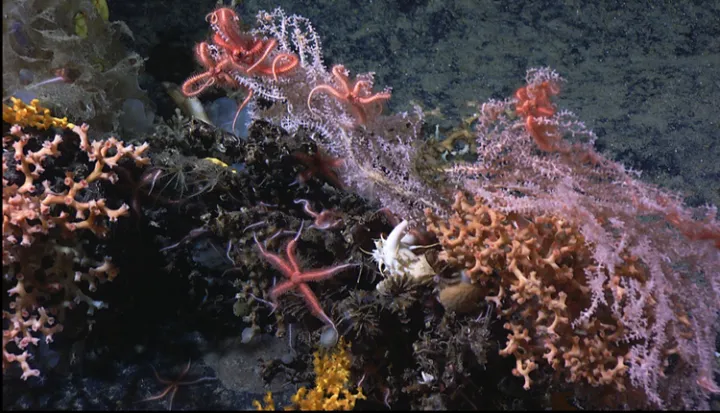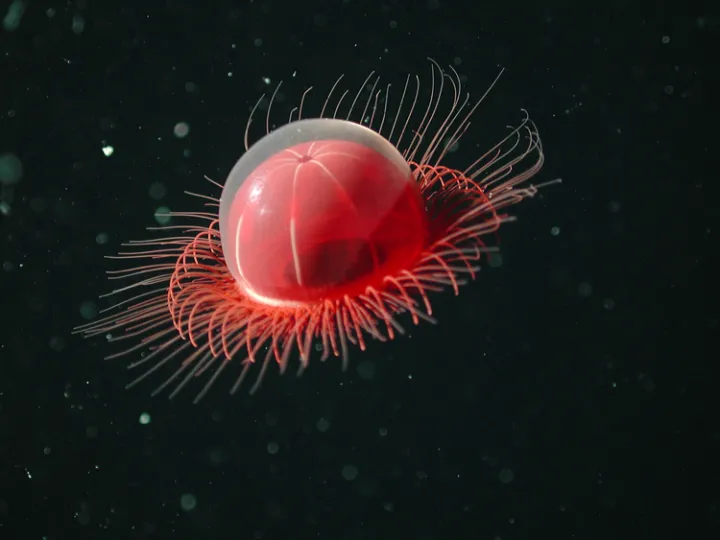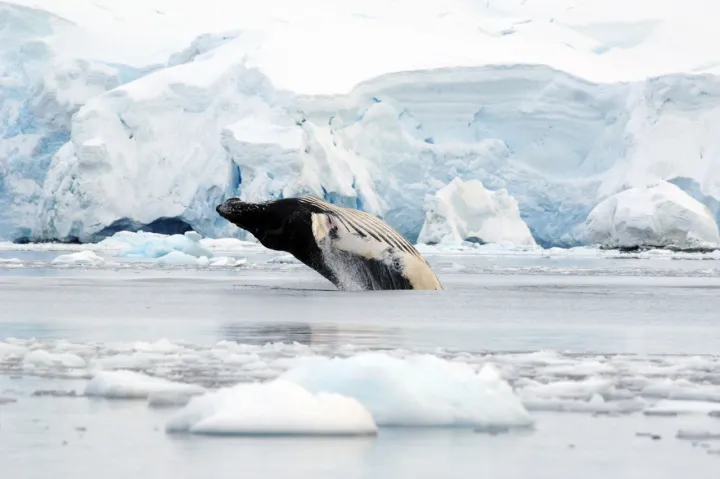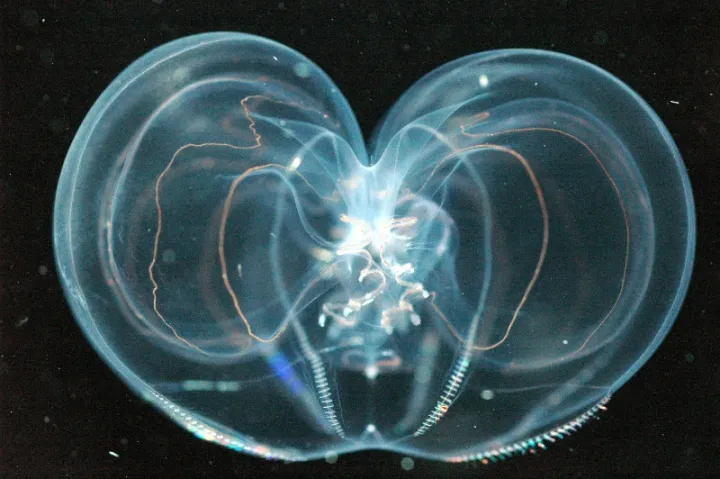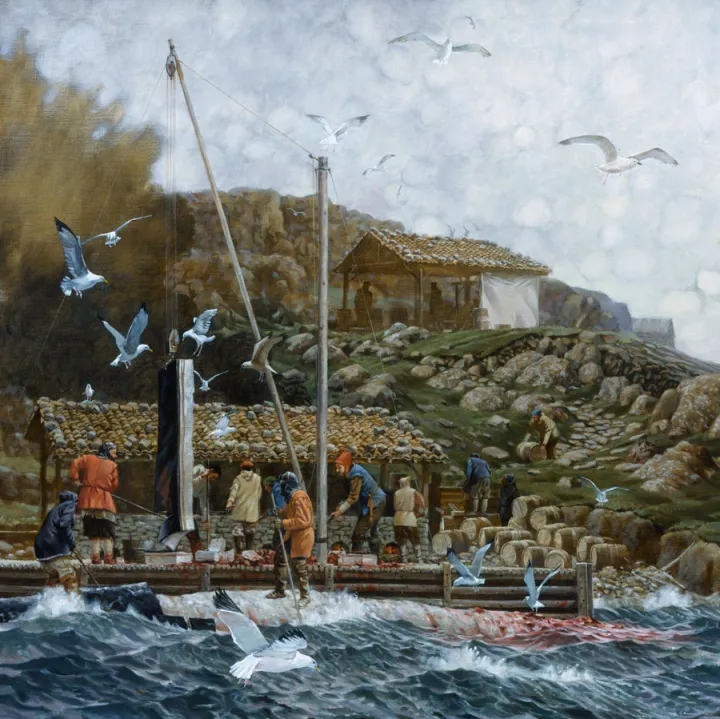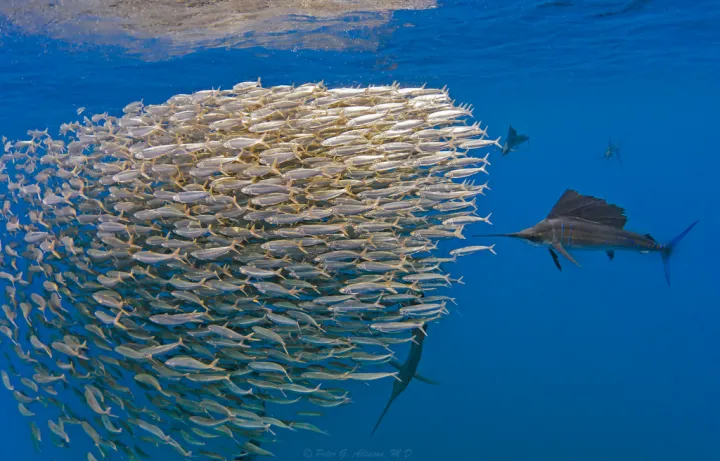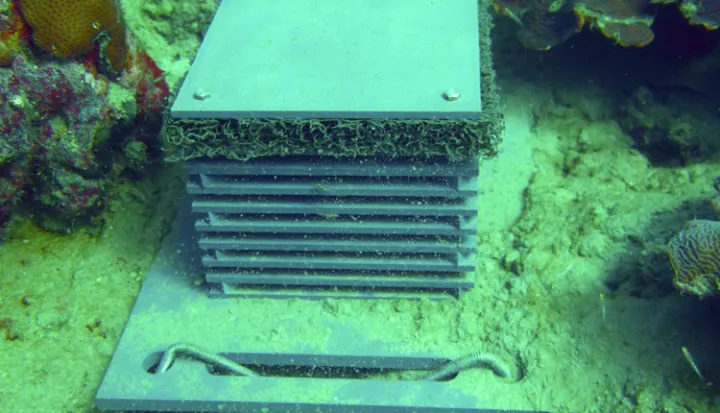
The Census of Marine Life
Introduction
Did you know that over 17,000 species thrive in the deep sea where no light penetrates the ocean waves? Or that an old restaurant menu can teach us about the history of fish populations? Or that there are 38,000 different kinds of microbes in a liter of seawater? These were all discoveries made by the Census of Marine Life, a 10-year international effort that assessed the diversity (how many different kinds), distribution (where they live), and abundance (how many individuals) of marine life. The effort brought together unprecedented amounts of information on marine species into databases that provide a ‘phone book’ of sorts for the ocean.
During the decade of the Census of Marine Life, more than 6,000 potential new ocean species were discovered by the roughly 2,700 participating scientists from more than 80 countries. Census scientists searched the global ocean to learn more about species as large as the blue whale and as small as a zooplankter or microbe. They sampled from the world's coldest regions to the warm tropics, from deep-sea hydrothermal vents to coastal ecosystems. They tracked the movements of fish and dug up studies from long ago to learn what the ocean used to be like before the influence of humans. And, of course, the scientists also used this information about the past and present to consider what the future holds for the ocean.
The scope of the Census of Marine Life was unprecedented and inspired authors and artists to tell its story. In 2011 the Census Scientific Steering Committee received the prestigious COSMOS prize in recognition of its decade of international ocean research spanning multiple scientific disciplines.
Human Edges
Humans may not be able to breathe underwater but they still hugely influence the ocean, especially along coastlines, where over 600 million people live. Even more people rely on the ocean for fish, recreation and beauty.
Natural Geography in Shore Areas
The Japanese word "nagisa" means the narrow strip where the land meets the sea. The Natural Geography In Shore Areas (NaGISA) project wanted to determine what organisms live in these coastal zones around the world.
The nearshore zone of the ocean—defined by the Census as the coastal areas to a depth of around 65 feet (20 meters)—is the most-studied region of the ocean because it is so easy to access from land. But surprisingly, we still don’t know how many species live by the shore: estimates vary widely, from 178,000 species to more than 10 million.
NaGISA scientists pulled on their boots and waded and dived in coastal waters around the world to estimate the number of species on our coasts more precisely. A reliable estimate should help scientists understand how diversity is changing over time, and allow them to answer big questions about the ocean, such as why there is more diversity in the tropics.
The coastal region has many types of ecosystems, too many for the researchers to account for, so they focused on just two: the rocky bottoms dominated by kelp forests and other seaweeds and soft-bottom areas covered by seagrasses. They chose these areas because they have high biodiversity and are found throughout the world, so researchers can work together to compare their discoveries from different sites.
Census of Coral Reefs
Coral reefs are some of the most iconic seascapes in the world and are also the most diverse of marine ecosystems. Reef-building corals provide homes to fish and invertebrates and support coastal ecosystems by protecting the shoreline. The Census of Coral Reefs (CReefs) brought together coral reef scientists from around the world to learn more about what kinds of animals live on the world's reefs and to develop new methods of measuring that diversity. One major outcome of the project was the invention of new techniques to sample coral reef biodiversity the same way around the world using Autonomous Reef Monitoring Structures (ARMS) combined with DNA analysis.
Coral reef diversity is hard to monitor and assess because so many species are tiny, rare, and hidden in the framework of the reef. This makes studies by different scientists difficult to compare because slight changes in technique can produce very different results. To minimize those differences, the scientists developed ARMS: a small apartment complex for coral reef organisms (made of heavy plastic and astroturf) that can be left on the reef for a year or more. Scientists can place ARMS at reefs around the world, allowing them to compare their findings across the global ocean over time and space. Using molecular barcoding, a small amount of tissue—a small piece of a fish’s fin or a coral polyp, for example—contains enough information in its DNA to tell scientists what the species is, even if they don’t know where the tissue sample came from. This makes species identification faster, easier and more reliable.
Gulf of Maine Area Program
The Gulf of Maine is bounded by Cape Cod, which juts out from the state of Massachusetts like a hook, and Canada's Nova Scotia coast. It is a well-researched area because it supports major fisheries, is close to a populated coastline, and has a large diversity of habitats, currents and species. Before the launch of the Census’s Gulf of Maine Area (GoMA) program, scientists thought that 2,000 species lived in the region. By the end of the decade, that number had doubled to more than 4,000 named species in the Gulf of Maine Register of Marine Species.
Because fish and fishing play such important roles in this ecosystem, particular species such as cod and lobster have been well studied. But general biodiversity and how those species interact in ecosystems are also important and are still not completely understood.
To assess the diversity of fish and where they live, scientists explored years of data collected from trawl surveys by the Northeast Fisheries Science Center. In a trawl survey, scientists pull a net through the water to catch fish, plankton, or other organisms to get a sense of what is most common in the area. The GoMA scientists identified two 'hotspots' where many species were found, but, overall, biodiversity varied greatly throughout the entire region. They also looked at historical records of the cod population and general diversity in tidal areas to better understand how the region has changed over time.
Animal Movements
The Pacific Ocean Shelf Tracking (POST) and Tagging of Pacific Predators (TOPP) projects focused on learning where animals move throughout the ocean to get insight into patterns of migration, feeding and mating.
Pacific Ocean Shelf Tracking Project
Imagine a tracking system that sits on the ocean floor and can tell you when and where animals are moving. The Pacific Ocean Shelf Tracking project did just that, focusing on tracking the movements of Pacific salmon. Salmon often die during their time spent in the ocean, so this system helps to gather more information about when and where those deaths occur, and about the traits of animals which survive.
POST scientists placed tags that send out sound waves on juvenile salmon (as well as other species). When they swam by acoustic receivers embedded in the ocean floor, the receivers recorded information about their movement—direction, speed and timing—and told researchers which individual animal had swum by. Squid, sharks, salmon and other fish species made up the roughly 16,000 animals tagged and followed along the 3,000 miles of receivers on the west coast of North America, from the Alaskan coast down to central California.
Tagging of Pacific Predators
Animals that live throughout the open ocean are often hard to track, so we know little about their life cycle and habits. By using new tagging technology, scientists with the TOPP research program were able to virtually dive along with large animals that roam the open ocean. Tags on large animals such as sharks, sea turtles, tuna, whales, birds, seals and even squids not only allow for very cool tracking capabilities, but also help researchers learn more about breeding and feeding habits, as well as migration paths of these large animals. Additionally, the tags were monitoring important oceanographic information that can help increase our knowledge about the many ocean layers.
The ocean may seem featureless to us, but not to the organisms that dwell there. The study found that many predatory animals, including sharks, sea turtles ands whales, congregate off the coast of California in an area called the California Current. There, cold, nutrient-rich water moves towards the surface from the deep, bringing with it squid, sardines, krill and other prey that that attract the predatory animals. An inter-ocean highway of sorts was also found between Japan and Northern California where animals moved between the two areas in a Serengeti-like fashion called the North Pacific Transition Zone.
Deep-sea Floor
Most of the ocean is very difficult for humans to reach and explore. Coastal shallow areas are relatively easy to access, but these continental shelves that extend from the shorelines only make up ten percent of the ocean. Five Census projects explored the hard-to-reach areas of the ocean: continental margins (the point where the continental shelf slopes down to meet the abyssal plain), the abyssal plain (the muddy seafloor past the continental slope), the Mid-Atlantic Ridge (part of the longest mountain range on the planet), and the once unsuspected ecosystems that thrive on chemical seeps and whale falls.
Continental Margin Ecosystems
The area where the continental slope drops precipitously into the abyssal plain is covered with a mixture of sediment, rocky mountain outcrops, diverse organisms and very strong gradients. Such a quick change in depth and the amount of light causes extreme differences between the abyssal plain and its slope neighbor in temperature, oxygen and pressure, to name a few. Here, it’s too dark for photosynthesis, so animals must adapt to the dark where food is scarce.
With increased sampling and mapping capabilities, scientists in the Continental Margin Ecosystems project (COMARGE) explored deep-ocean margins during more than 60 expeditions. They found life throughout the continental margin, but researchers determined there are more types of deep-sea species at the mid-point of the continental slope, at around 2,000-3,000 meters, where cooler water is pushed up towards the water’s surface.
Census of Diversity of Abyssal Marine Life
What do you think of when you imagine the very deep-sea floor? If it's a dark expanse of smooth mud, then you are picturing the abyssal plain. Despite its lack of topographical diversity, there is an abundance of life found in the miles and miles of mud. Census of Diversity of Abyssal Marine Life (CeDAMar) scientists asked questions about how many species were living in this ecosystem, and if those species varied within the vast space of the abyssal plain. The area covers 30 percent of the Earth’s surface, more than the entire landmass of the continents. Is it all the same from ocean basin to ocean basin, or does it vary just like the species and landscapes we see on land do?
CeDAMar scientists described and mapped 500 new abyssal species, helping to improve our knowledge of what lives where in the ocean, and why organisms are distributed the way they are. These areas seem so far removed from the human touch, but issues like climate change, mineral and gas extraction, and seafloor trawling can greatly impact the animals that live on the abyssal plain.
Mid-Atlantic Ridge Ecosystems Project
Parts of the abyss are far from flat and featureless. The Mid-Atlantic Ridge Ecosystems project (MarEco) focused on life near and over a large underwater volcanic mountain chain that runs from Iceland to the Azores. They found 1,000 species, almost 40 of those new, ranging from whales to anglerfish with strange lures to tiny crustaceans.
The MarEco team used a variety of technologies including submersibles and remote sensing to reach these remote locations. Most animals preferred spots where warm and cold waters meet, which tend to be nutrient-rich. Some species lived on both the Mid-Atlantic Ridge and along continental slopes—but the populations mostly didn’t mix with one another and were genetically isolated. This information about patterns of distribution and species abundance can help show where exactly these communities exist and how species within them interact.
Census of Seamounts
Towering mountains make for beautiful scenery—even when they are found deep on the ocean floor. CenSeam (the Census of Seamounts) set out to learn more about these underexplored habitats, which are often isolated and can sustain a large number of species that aren’t found elsewhere. Scientists gathered information on what are estimated to be over 30,000 seamounts throughout the world's ocean. Many of these originated from underwater volcanoes, and most have enough of a current running along the slope that enough food can make its way to the deep areas. This combination of conditions is very inviting for species looking for a safe and reliable home to feed or care for young.
Technology now allows fishing boats to easily locate seamounts and catch long-lived, slow-growing fish, such as orange roughy, that live there. Learning about the impact of these new human exploitations on the seamount ecosystems is important to their conservation—one of the many reasons CenSeam researchers wanted to study how seamounts compare globally. Trawling and other disturbances can lead to an especially difficult recovery for seamount organisms because they are isolated and grow slowly.
Biogeography of Deep-Water Chemosynthetic Ecosystems
Imagine exploring the dark sea floor and coming across a plume of thick, gray “smoke” emerging from the rocks; where would you think it came from? When deep-sea tectonic plates shift, cracks open on the ocean floor and cold seawater leaks down into the crust. There, it mixes with extremely hot rock (350 degrees Celsius), allowing metals and sulfur from the rock to dissolve into the seawater. This highly charged and now-hot seawater then rises up, sometimes reacting with cold deep-sea water to produce particles that looks like dark smoke. These particles land on the sea floor and form chimneys on the vents that can grow to be 40 meters (131 feet) tall.
The Biogeography of Deep-Water Chemosynthetic Ecosystems (ChEss) project wanted to better understand all of these deep-sea chemical processes. Among these extremely hot and volatile vents are entire communities sustained by bacteria that use the vent chemicals to produce energy, like the giant tubeworm (Riftia) that maintains a symbiotic relationship with the bacteria to survive.
Chemical reactions are not only found at hydrothermal vents in the deep-sea, but also in areas where cold, methane-filled water seeps up through ridges, in deep-sea areas where dead whales fall to the ocean floor, and deep in the oceanic crust. Scientists with the ChEss project found the hottest and deepest vents ever, discovered new hydrothermal vent and cold seep locations, and described more than 170 new species.
Ice Oceans
The Arctic Ocean Diversity (ArcOD) project and the Census of Marine Antarctic Life (CAML) brought international researchers together to record biodiversity in the Arctic and Antarctic: from the sea ice, water column and sea floor, ranging from the shallow shelves to deep basins of the ocean. Researchers found more than 300 species that seemed to occur in both the Arctic and Antarctic oceans despite the great distance. But things aren’t always as they seem; genetic testing shows that most are, by and large, not the same species.
Arctic Ocean Diversity
Can you imagine trying to scoop up some seawater and feeling worried that a polar bear might sneak up behind you? Researchers in the ArcOD project had to live with that possibility daily, but remained safe by always having a lookout. They brought together existing information about the diversity of Arctic ecosystems, collected new samples to fill in gaps of knowledge, and looked for species and community changes over time in the region. Determining a baseline of information about the Arctic is especially important with temperatures warming and ice melting faster in the Arctic than anywhere else. Even in the short time since the Census, changes in the range and type of species found in the region have already been observed.
The Arctic is home to many forms of life that have adapted to some of the most extreme conditions. The ArcOD project catalogued life ranging from meiofauna (small invertebrates invisible to the human eye) and plankton that call the sea ice home, to sea stars and crabs, sea birds and marine mammals.
Census of Marine Antarctic Life
Where do whales go to feed? How do penguins find their food source? Why do schools of krill move to particular places? These are the types of questions that researchers explored in the Antarctic. Top predators there include whales, seals and penguins, all of which rely heavily on krill, squid and fish in the open ocean for food. Scientists gathered information on the movement and habitats of both predators and prey in order to better understand how they interact. They also explored much smaller organisms, such as Antarctic microbes, which help to produce and move energy and nutrients, an effort that impacts much larger organisms.
CAML scientists found that cold-loving species are huddling closer to the cold water at both poles as warm ocean water spreads. There are also areas of the Arctic that have recently been exposed to sunlight for the first time in 100,000 years as ice sheets melt. Researchers believe that when Antarctic ice expands, parts of the chilly waters are cut off from the rest of the ocean by the ice, giving species the chance to evolve. Once the iced-off areas are free, these animals can take off toward warmer waters where they increase the variety of species. Understanding changes like this that have occurred in the past can help scientists to predict more clearly what might happen in the future with a warming climate.
Beyond the Human Eye
Most of the life in the ocean we can't see with the naked eye: microbes. In addition to the microscopic viruses, bacteria and other microbes are the plankton, tiny plants (phytoplankton) and animals (zooplankton) that drift with the ocean currents. The International Census of Marine Microbes (ICOMM) and the Census of Marine Zooplankton (CMarZ) explored these tiny but important forms of life that are found around the planet.
International Census of Marine Microbes
What is in the ocean water that you might gulp by mistake while taking a swim? The Census found that the average liter of ocean water holds around 38,000 kinds of microbial bacteria. The vast majority of these microbes aren’t gross germs; rather, they support all life.
The ocean is full of microbial life: ninety percent of the ocean’s total weight of organisms is microbes, invisible to the naked eye. The group is made up of viral particles, bacteria and other single-celled life. Microbial communities can thrive where you would expect no life to survive, such as at deep-sea hydrothermal vents or deep in the ocean’s crust. They pull carbon from rocks and make it available to other organisms, form the base of the marine food web, and produce much of the oxygen that we breathe. Because their diversity is almost beyond measure, there are large gaps in knowledge about these abundant and tiny organisms.
ICOMM scientists focused on cataloguing already-known marine single-celled organisms, discovering unknown microbial diversity, and fitting what we know about microbes into the greater context of evolution and ecosystems. The project developed a microbial database, MICROBIS, that houses this information.
Census of Marine Zooplankton
The ocean is full of tiny plants and animals drifting on the currents; almost 7,000 different kinds of zooplankton had already been described before the CMarZ project joined the search. Some species are alien-like, while others look like tiny jellyfish or bugs. They feed on microscopic plant species or other zooplankton, and in turn are eaten by fish and other animals. By the time the collections from CMarZ are analyzed, it is estimated that over 14,000 species will be described.
The scientists focused on the deep sea, under-sampled regions (such as the waters of Southeast Asia), and biodiversity hotspots, identifying species visually and through DNA barcoding. The scientists collected zooplankton at the deepest regions yet—more than 16,000 feet (5,000 meters)—and developed technology to perform DNA barcoding at sea.
Overall, these efforts produced the most comprehensive global view of zooplankton diversity, distribution, and abundance to date. The researchers found new and rare species, as well as hidden areas of diversity in places like the Arctic and the deep sea. This knowledge will provide a benchmark against which future changes resulting from climate change or other human-caused and natural variation can be measured.
Past & Future Ocean
In order to plan for the future of the ocean, the past needs to be understood. Two Census projects focused on learning more about both the past and the future: the History of Marine Animal Populations (HMAP) and Future of Marine Animal Populations (FMAP).
History of Marine Animal Populations
What do we know about the ocean of the past? How have humans interacted with the sea over time? These were the questions that the History of Marine Animal Populations project set out to answer. Around 100 researchers joined forces and analyzed historical population data of marine species. Not only is it important to learn about how the number of animals changed over time, but also how their traits, such as the size of caught fish, have changed. These are all vital pieces to understand how humans have impacted animal populations and the best way to conserve them.
The analysis provides a better understanding of how populations of marine species have changed over time due to human fishing impacts, going back 500 to 2,000 years in the past, providing an improved baseline of information that can help to tell the story of our ocean better. Their methods ranged from archeology digs to reading historical documents, even including old menus and reviewing trophy-fishing photos.
Future of Marine Animal Populations
Once the gaps of the past are filled in with as much knowledge as possible, what do researchers do with the information? The FMAP project took the baseline of information created from the HMAP project and looked for patterns and information that could be modeled to predict future changes to the ocean.
FMAP scientists found that 90% of large predators have already been taken out of the ocean by fishing. The models showed that, compared to 1950, the ocean has 40% less phytoplankton, small algae that are the basis of the ocean food web, and that human impacts are degrading coral reefs as well as increasing the risk of marine populations going extinct. This information about how our ocean has changed will help to answer questions about what animal populations will look like in the future.
Legacy
Although the Census of Marine Life was a ten-year project, concluding in 2010, its legacy continues on in the many projects that resulted from Census collaborations and in the scientific data that was compiled during the decade of work from over 2,500 scientists.
Ocean Biogeographic Information System
The Ocean Biogeographic Information System (OBIS) is a portal to marine datasets that integrates the large amounts of information coming out of the ten-year Census and other sources. OBIS is the largest online repository of data associated with specific locations, and it is expected to continue to grow in the years to come. With the ability to search by species, location, depth and time, users of the database range from scientists to educators. It is especially useful for its ability to show large-scale ecosystem patterns and relationships between species and their environments.
Ongoing Projects
At the conclusion of the Census of Marine Life, in 2010, over a decade of new ocean research had been initiated. But the research didn't stop dead in the water: collaborations and work continues even today. Groups brought together by the Census, such as the biodiversity working group of the Arctic Council and the International network for Scientific investigation of deep-sea ecosystems, are working on projects that continue to increase our knowledge of the ocean's unknowns. The Autonomous Reef Monitoring Structures (ARMS) created to standardize sampling for the Census of Coral Reefs are still being used today around the world. The ARMS are even being used for deep reef monitoring, and have been incorporated into the Smithsonian’s Tennenbaum Marine Observatories, which will monitor coastal ecosystems over an extended period of time from field sites all over the world.
Additional Resources
Books
Knowlton, Nancy. Citizens of the Sea: Wondrous Creatures from the Census of Marine Life. Washington, D.C.:National Geographic, 2010.
McIntyre, Alasdair D. Life in the World's Oceans: Diversity, Distribution and Abundance. Wiley-Blackwell, 2010.
Snelgrove, Paul V.R. Discoveries of the Census of Marine Life: Making Ocean Life Count. Cambridge: Cambridge University Press, 2010.
Online
A TED talk from Paul Snelgrove about synthesizing the information from the Census
The full Census of Marine Life website
Poem, "The Census of Marine Life is about the total richness of the sea" (pdf)


